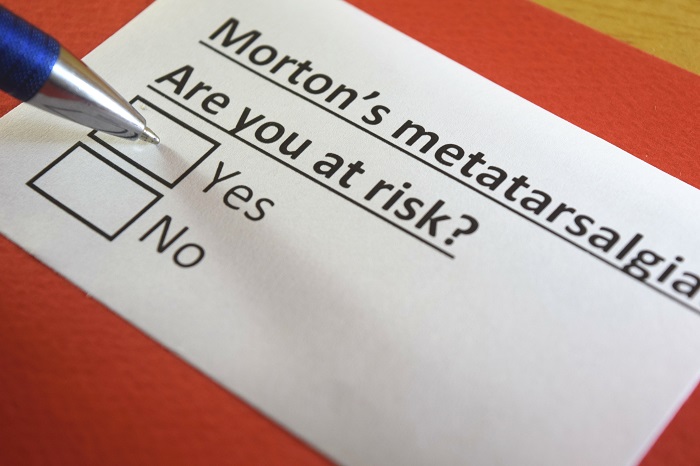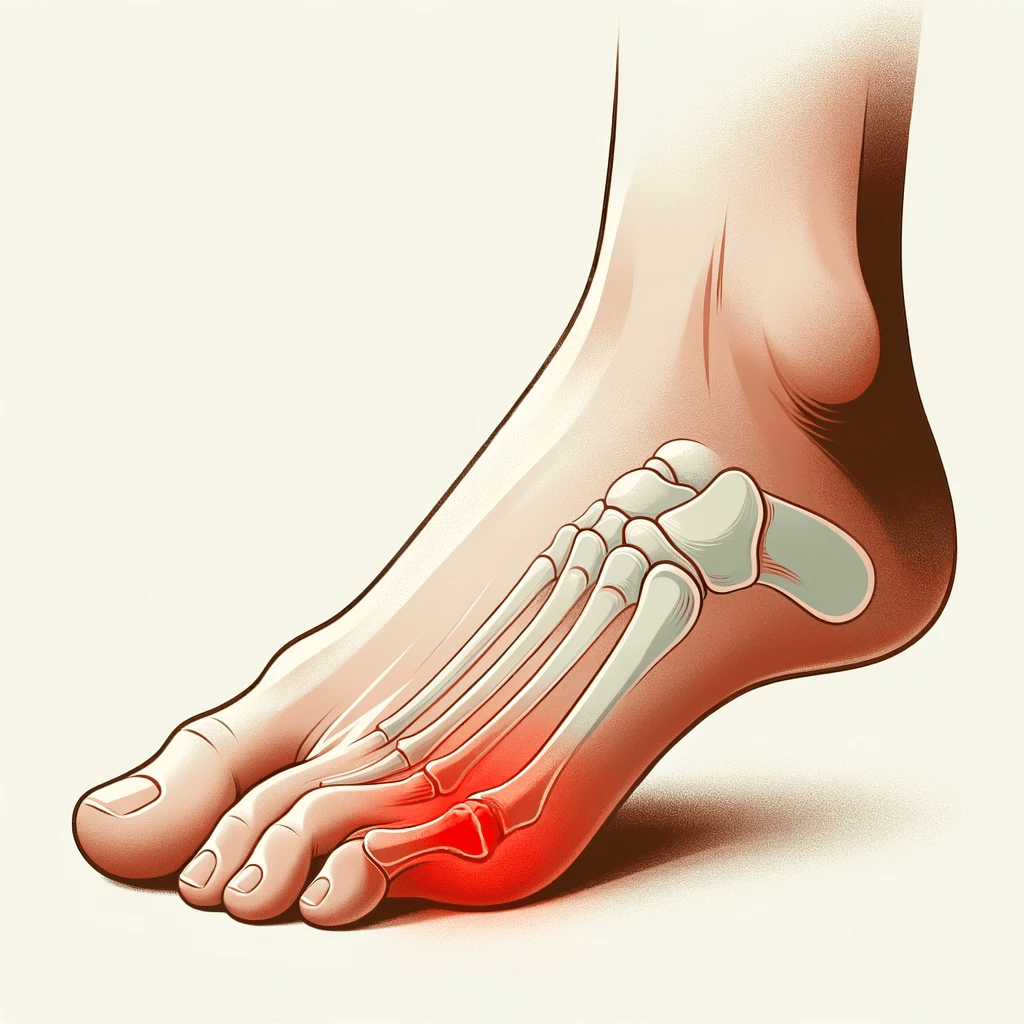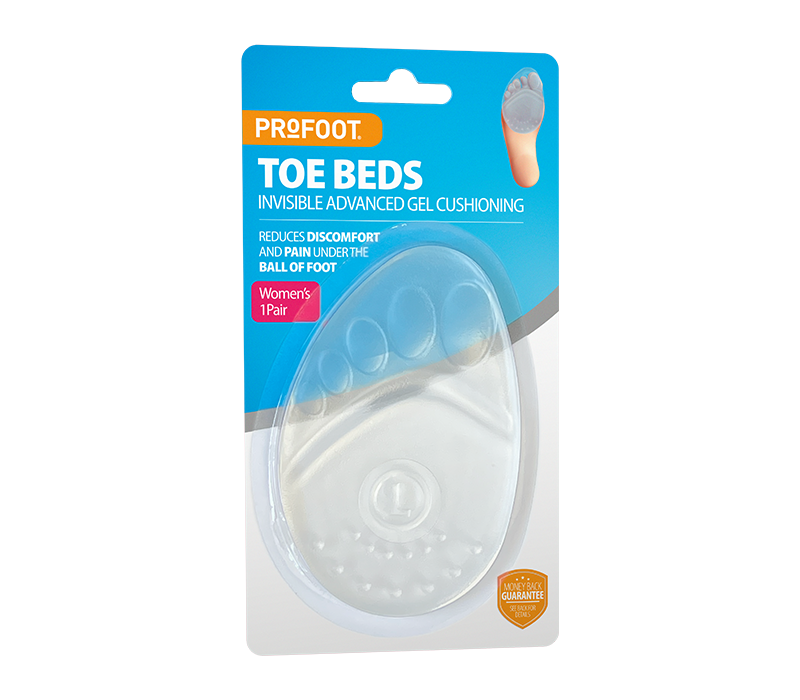Phone: +44 (0)20 8492 1600
Need help or have a question?
Contact us at: [email protected]
If you’re experiencing pain in the ball of your foot or a burning sensation in your toes, you may be suffering from Morton’s Neuroma. This condition that affects the nerves in your feet, causing pain, discomfort, and other symptoms. In this article, we’ll discuss the causes, symptoms and treatments.
Coping with this condition can be quite uncomfortable, but addressing it sooner rather than later increases your chances of finding relief.
If left untreated, it could cause permanent nerve damage and require more invasive treatments like surgery.
There are several non-invasive Morton’s neuroma treatments available. These include:
With these methods combined with professional medical help, you’ll have a greater chance of getting rid of the pain!

Morton’s Neuroma commonly affects women more than men, typically striking those between 30 and 50 years old. This foot ailment occurs in the space between the third and fourth toes, where the tissue around a nerve thickens, causing compression and irritation. This leads to discomfort and pain, turning activities like walking or standing for extended periods a challenging and uncomfortable experience.
At Profoot, we recognise the discomfort caused by Morton’s Neuroma. To help, we provide a range of inserts and arch supports tailored for this condition. These products aim to ease your pain, enabling you to comfortably resume your daily activities.
The symptoms of Morton’s Neuroma can vary from person to person, but a sharp, burning pain in the ball of your foot is the most common. Other symptoms can include:
Why this condition can suddenly flare up remains unknown, but there are several factors that can contribute to its development. One common factor is wearing tight-fitting shoes or high heels for extended periods.
Another potential cause of Morton’s neuroma is foot deformities such as flat feet, bunions or high arches. These conditions can put extra pressure on the nerves in your feet and lead to inflammation and swelling.
In some cases, trauma or an injury to the foot may also be a contributing factor.
This could include repetitive stress injuries from activities like running or jumping.
When experiencing symptoms associated with Morton’s Neuroma, a doctor may run tests to confirm the condition.
| Test | Description |
|---|---|
| Mulder’s Click Test | Physical examination where the doctor squeezes both sides of the forefoot, checking for clicking sensations between metatarsal bones. |
| X-Rays and Ultrasound | Used for deeper insight into foot structure, helping to pinpoint the problem’s location and severity. |
| Magnetic Resonance Imaging (MRI) | May be necessary for detailed information on soft tissue structures around the nerve. |
| Diagnosis and Treatment | Varies based on severity; options range from conservative approaches like rest and shoe inserts to surgery for removing the affected nerve or relieving pressure. |
While there is no definitive cure, with proper care and management, those diagnosed with this condition can expect an improved quality of life without having to endure chronic foot pain or other associated problems.
Prevention is definitely key when it comes to managing Morton’s neuroma. Wearing properly fitted shoes with supportive arches and avoiding high heels can reduce your risk of developing this painful condition.
Home treatments can be the first step in treating Morton’s Neuroma and may provide relief. One of the most common treatments is wearing appropriate footwear with spacious toe boxes that allow toes to move freely without pressure or compression. Additionally, using our Toe beds or bunion pads can help alleviate pain by reducing pressure on the affected nerve. They work by redistributing weight across the foot and providing extra cushioning for shock absorption.
Another option for treatment is physical therapy. A podiatrist or doctor can give you exercises designed to stretch and strengthen muscles around the affected area, which can reduce inflammation and ease discomfort caused by Morton’s Neuroma symptoms. With consistent exercise and proper technique, patients may experience an improvement in their overall mobility as well as a reduction in their symptoms over time.
In certain instances, these measures may not fully resolve Morton’s Neuroma. However, when correctly applied in conjunction with other medical interventions, like surgery if needed, they can provide significant relief.
In conclusion, before resorting to invasive procedures like surgeries it would be wise to explore non-invasive options first such as conservative treatments including: changes in footwear, padding/orthotics use or even physical therapy sessions tailored specifically towards management of this type of injury – all aimed at symptom-relief while improving functionality & quality of life wherever possible!
If conservative treatments fail to provide relief, surgical intervention may be necessary to treat Morton’s Neuroma. Surgery is typically reserved for cases where the patient has persistent pain and discomfort that interferes with their daily activities despite trying non-invasive methods of treatment.
In this procedure, the surgeon will remove the affected nerve or release pressure on it by cutting surrounding tissues.
Obviously that there are some risks associated with any surgical procedure. It is important to discuss these risks with your doctor before deciding whether or not surgery is right for you. With proper care and recovery time, many patients experience significant improvement in their Morton’s Neuroma symptoms after surgery and are able to return to normal activities without discomfort or pain.

Preventing recurrence is crucial to avoid further complications.
The first step in preventing its recurrence is recognising and managing the symptoms. Morton’s Neuroma symptoms include pain, burning sensation, numbness, or tingling between your toes. If you experience any of these symptoms, it is essential to seek medical attention immediately.
The second step is following a proper treatment plan. A podiatrist may recommend certain treatments such as custom orthotics or steroid injections to relieve the pain and swelling associated with this condition. Additionally, they might suggest physical therapy exercises that can help strengthen the muscles around the affected nerve.
Finally, wearing appropriate footwear with ball of foot cushion inserts can also prevent the recurrence of Morton’s Neuroma. These cushions provide extra support and comfort to your feet while reducing pressure on the nerves in your toes.
By considering these steps, individuals experiencing this condition can effectively manage it and prevent future episodes without causing disruptions to their daily lives.
Morton’s Neuroma affects about 1 in every 10 people and is more prevalent among women than men. Typically affecting people between the ages of 30 and 50 years old.
Yes, there are several ways reduce your risk of developing this painful condition.
First and foremost, wearing comfortable shoes with enough room for your toes can go a long way in preventing the compression of nerves that causes Morton’s Neuroma. Additionally, avoiding high heels or narrow-toed shoes can also help alleviate pressure on your feet.
Regular exercise and maintaining a healthy weight play a crucial role in reducing the risk of Morton’s Neuroma. Additionally, proper foot care, including stretching and massaging your feet, further diminishes the likelihood of encountering this discomforting condition.
By taking these preventative measures, you’ll not only protect yourself from Morton’s Neuroma but also show kindness to your hardworking feet.
Surgery isn’t always necessary when it comes to treating Morton’s Neuroma. While it can cause intense pain and discomfort, there are a variety of non-surgical options that may be effective in alleviating symptoms.
From custom orthotics and shoe inserts to physical therapy and medication, there are plenty of ways to treat this condition without going under the knife. Of course, every case is different.
Yes, wearing high-heeled shoes can be a cause of Morton’s Neuroma. The constant pressure on the forefoot from wearing high heels or narrow-toed shoes can lead to nerve damage and inflammation in the ball of the foot.
People have found relief through stretching exercises, massage therapy, and wearing shoes with a wider toe box.
As always, we recommend talking to your Doctor or podiatrist before trying any new treatments or remedies.

Profoot offers a range of products designed to help manage the symptoms of Morton’s Neuroma and other foot conditions. These include:
Our Toe beds are designed to provide targeted cushioning to the balls of your feet, which can help reduce pressure and alleviate pain.
The Gel ball of foot cushion help relive pain in the ball of the foot and are used by chiropodists worldwide.
Insoles: Profoot’s Insoles are designed to provide all-day comfort and support to your feet, helping to distribute pressure evenly and reduce the risk of developing foot conditions like Morton’s Neuroma.
Arch Supports: Profoot’s Triad Insoles and Super Sport are designed to help support your feet and reduce stress on your arches, which can help alleviate pain and reduce the risk of developing foot conditions.
Toe Separators: Profoot Toe Separators are designed to help align your toes, which can help alleviate pain and prevent the development of Morton’s Neuroma.
Toe Support: The Profoot toe support helps relive hammer toe or toe curl which is a suspected cause of Morton’s Neuroma.
These products are designed with the latest technology and materials to ensure maximum comfort and support, and they are all backed by Profoot’s commitment to quality and customer satisfaction.
In conclusion, this is a widespread foot condition. It often leads to pain and discomfort in the ball of your foot. This can make walking or standing for extended periods challenging. However, as highlighted in this article, various treatments are available. These treatments can significantly alleviate the symptoms.
As always we recommend speaking to a doctor or podiatrist if you suspect you have this or any foot condition. Treatment options can be as easy as wearing looser shoes or using our ball of foot cushion. Or you may need physical therapy or injections and surgery.
While high heels may not directly cause Morton’s Neuroma, they can exacerbate existing conditions so consider changing footwear choices.
Remember, your feet are your connection with the world!
This article was written by Dr. James Philip MBChB who graduated from the University of Manchester in 2015 and went on to train in hospitals across the North West of England. He has experience working in both hospital medicine, and the community, and played his part as a front line worker on the COVID-19 wards. He now works as a freelance medical writer and medical education entrepreneur.